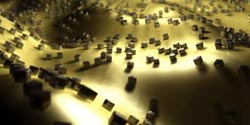Silver nanocubes make super light absorbers

These are nanocubes.<br>Credit: Cristian Ciraci
Metamaterials are man-made materials that have properties often absent in natural materials. They are constructed to provide exquisite control over the properties of waves, such as light. Creating these materials for visible light is still a technological challenge that has traditionally been achieved by lithography, in which metallic patterns are etched onto an inert material, much like an ink-jet printer.
As effective as lithography has been in creating such structures, it does have a limitation – it is very expensive and thus difficult to scale up to the large surface areas required for many applications.
“Our new approach is more of a bottom-up process,” said Cristian Ciracì, research scientist at Duke's Pratt School of Engineering. “It may allow us to create devices – such as efficient solar panels – that cover much larger areas. In our experiments, we demonstrated an extraordinarily simple method to achieve this.”
The results of Ciracì and co-workers' experiments, which were conducted in the laboratory of senior researcher David R. Smith, William Bevan Professor of electrical and computer engineering at Duke, were published Dec. 6 in the journal Nature.
For many applications or devices, the key is the material's ability to control the absorption of electromagnetic waves. Metals, for example, can be highly reflective on their own, which may be beneficial for some applications, but for something like a solar cell, optimal light absorption is desired.
“However, metamaterials based on metallic elements are particularly efficient as absorbers because both the electrical and magnetic properties of the material can be controlled by how we design them,” Ciracì said.
The new metamaterial developed by the Duke team has three major components – a thin layer of gold film coated with a nano-thin layer of an insulator, topped off with a dusting of millions of self-assembled nanocubes. In the current experiments, the nanocubes were fabricated out of silver.
“The nanocubes are literally scattered on the gold film and we can control the properties of the material by varying the geometry of the construct,” Ciracì said. “The absorptivity of large surface areas can now be controlled using this method at scales out of reach of lithography.”
While metals on their own tend to have reflective properties, the nanocubes act as tiny antennae that can cancel out the reflectance of the metal surface.S
“By combining different components of the metamaterial elements together into a single composite, more complicated reflectance spectra could be engineered, achieving a level of control needed in more exotic applications, such as dynamic inks,” Ciracì said.
The research was supported by the Air Force Office of Scientific Research and by the Army Research Office's Multidisciplinary University Research Initiative (MURI).
The other members of the team were first author Antoine Moreau, Clermont University, France; Duke's Ryan Hill, Jack Mock, Benjamin Wiley and Ashutosh Chilkoti; and Qiang Wang from the Capital Normal University, Beijing.
“Controlled-reflectance surfaces with film-coupled colloidal nanoantennas,” A. Moreau, C. Ciraci, J. Mock, R. Hill, Q. Wang, B. Wiley, and A. Chilkoti. Nature, 6 Dec., 201
Media Contact
More Information:
http://www.duke.eduAll latest news from the category: Physics and Astronomy
This area deals with the fundamental laws and building blocks of nature and how they interact, the properties and the behavior of matter, and research into space and time and their structures.
innovations-report provides in-depth reports and articles on subjects such as astrophysics, laser technologies, nuclear, quantum, particle and solid-state physics, nanotechnologies, planetary research and findings (Mars, Venus) and developments related to the Hubble Telescope.
Newest articles

The future of digital agriculture
The Center for Digital Agriculture showcased the many advancements in digital agriculture during its annual conference. When the Center for Digital Agriculture (CDA) launched in 2018, they were looking forward…

Physicists arrange atoms in extremely close proximity
The technique opens possibilities for exploring exotic states of matter and building new quantum materials. Proximity is key for many quantum phenomena, as interactions between atoms are stronger when the…

For microscopic organisms, ocean currents act as ‘expressway’ to deeper depths
New research shows how tiny plant-like organisms hitch a ride on ocean currents to reach darker and deeper depths, where they impact carbon cycling and microbial dynamics in the subtropical…





















